Lately, there’s been quite a bit of debate about what it means to be a “Final Fantasy game.” For some, that means a traditional turn-based RPG. For others, that’s a boring system that calls for a shift to real-time combat, much to the chagrin of the former group.
As someone who’s been playing Final Fantasy games for more than half his life, I’ve heard these arguments for quite a while. But it’s with the iconic Square Enix series’ latest entry, Final Fantasy XVI, that I’ve seen arguably the most controversy. In some camps, the transition to full-blown action is a bridge too far, while others bemoan the lack of a truly open world, compelling side activities, and a racially diverse lineup of characters. Worse still, there are those who proclaim that XVI doesn’t feel like a Final Fantasy game.
While I understand and even agree with some of those criticisms, I push back heavily against the notion that this isn’t a Final Fantasy game. Indeed, Naoki Yoshida’s Creative Business Unit III, the Square Enix division behind XVI and the beloved XIV MMORPG, very clearly has a deep reverence for the ever-changing Final Fantasy series. And though Yoshida serves only as a producer on XVI, that same passion he exudes in XIV can be felt throughout, from the sincere and gripping narrative and characters to the phenomenal music and visuals — all core staples of a Final Fantasy game. There’s much more here than just loving nods to Black Mages, Chocobos and classic Dragoon poses. All the while, CBU III introduces a combat system that is absolutely masterful, creating one of the finest action experiences in recent memory. With all of this comes a well-rounded package that ranks among the series’ best while also pushing it forward in bold, meaningful ways.
Much more than a Game of Thrones pastiche
Spiritually, XVI hearkens back to the FFs of old with a purely medieval fantasy setting, Valisthea, following the futuristic sci-fi world of XIII and pseudo-modern locales of XV. Taking unabashed inspiration from Game of Thrones, XVI‘s flavour of old-fashioned backdrop is quintessentially European — so much so that Square Enix hired actors exclusively from the continent to add to the authenticity. But to the point of blending old and new, XVI does what few other FFs have done and commits to nuanced, thoughtful localization, as led by XIV veteran Michael-Christopher Koji Fox. Previous FFs have somewhat awkwardly been translated to the West with unnatural-sounding dialogue, but XVI, in the absolute best way possible, feels like it could be at home with a big-budget English HBO production.
Crucially, though, that isn’t used as a crutch, but rather to enhance the central narrative, which is already strong in its own right. The game begins with a lengthy section in which we follow Clive Rosfield, a dutiful young nobleman tasked with protecting his brother Joshua, a ‘Dominant’ capable of summoning the powerful Phoenix Eikon. However, a vicious attack on their kingdom sets Clive on a path of vengeance, which, in turn, drags him into a larger war involving Dominants from all nations.
The early days before Clive suffers unspeakable tragedy.
Admittedly, XVI‘s story is one of two disparate halves. The first is an earnest desire to explore themes of oppression which, unfortunately, don’t feel fully fleshed out over the course of the 40-hour campaign. That the game exclusively features Caucasian protagonists only makes the inelegant depiction of slaves — represented here through people known as ‘Bearers’ who are feared for their magical abilities — feel all the more clumsy. The game’s larger commentary on climate change, replete with Eikons serving as metaphors for nuclear weapons, doesn’t fare much better.
Having said that, there’s been some chatter about Final Fantasy XVI‘s story effectively being about Clive and other “white Europeans discovering that slavery is wrong,” and that, to me, is such a frustrating misreading of it all. Sure, it’s completely fair to criticize the game for its handling of this subject matter, but the more hyperbolic of comments as seen above — or others claiming XVI is a Game of Thrones-level blend of gratuitous violence, profanity and sex — are reductive and do a disservice to the actual numerous strengths of XVI‘s writing.
Above all else, Clive’s tale is demonstrably not about discovering that slavery is bad, but rather, one of self-discovery. What starts off as a typical revenge quest reveals itself to be a far more captivating fable about overcoming trauma. It’s about how an inherently kind-hearted man, once loyal to his brother, father, and people at large, finds himself so utterly broken and full of self-loathing before slowly learning how to love again — how to be loved again. Impressively, it’s both a moving character arc and a loving tribute to the prototypical taciturn Final Fantasy protagonist.
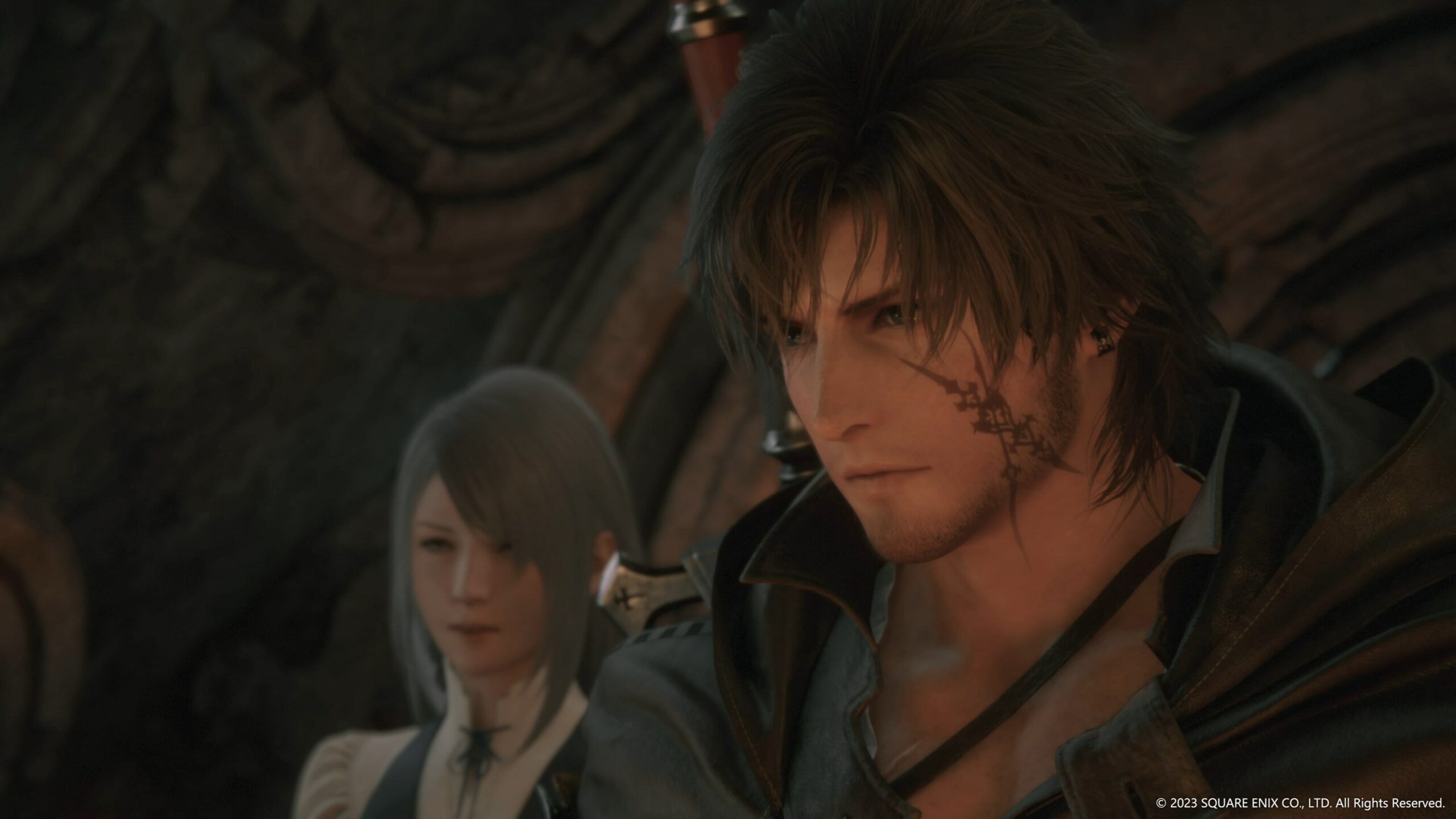
Clive is one of Final Fantasy’s best characters.
But unlike, say, VII‘s Cloud or VIII‘s Squall, XVI benefits from a chilling extended prologue that quickly establishes the root of our protagonist’s pain upfront, showing us the man Clive once was and rooting us in the journey he must take to reclaim that identity. In this way, XVI makes Clive the series’ best protagonist since Cloud while also giving him his own distinguishable personality. Indeed, much of the beauty of XVI‘s narrative lies in its quietest moments, allowing Clive to revisit the past with loved ones and exude the compassion buried deep within, be that by reconnecting with childhood friend, Jill, bonding with a bloodied soldier in a ditch, or taking the time to playfully teach some rascally kids. Across all of these scenes, be they gruelling or tender, Ben Starr delivers an absolutely mesmerizing performance, solidifying himself as the clear acting frontrunner come awards time.
Through Clive, XVI feels, at its heart, more like a so-called “true” Final Fantasy than some of the most recent numbered entries. The central reason why I’ve always loved this series, above any other, is because of exactly this sort of earnest and relatable characterization. We see that in VI with Celes, an Imperial turncoat who struggles with loneliness and depression. We see that in VII with Cloud, a fierce warrior whose cold exterior shields profound, everyday insecurities. We see that in IX with Vivi, a lovable little lad who has to grapple with weighty existential questions at such a young age. Ever since the series shifted towards more sophisticated storytelling in its fourth entry through protagonist Cecil Harvey’s story of redemption, Final Fantasy has always been about empathy, and nowhere is that better exemplified than Clive.
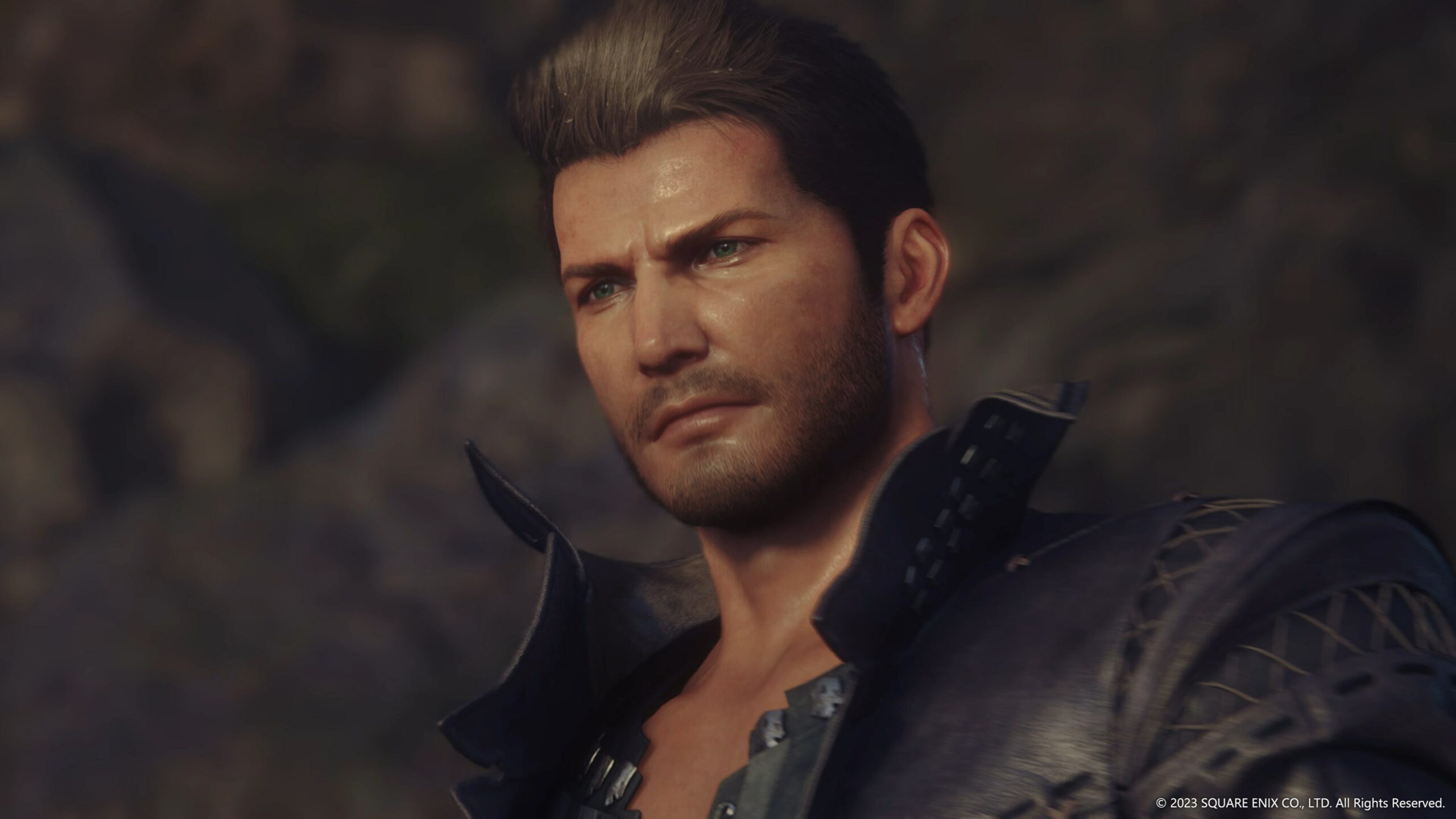
Pretty much every Final Fantasy game has a Cid, but XVI’s is arguably the very best.
Greater still, XVI extends that love and care to its solid supporting cast. There’s the lovable rogue Cid, who inspires Clive and a band of other outlaws to fight back against the oppressors and fight for a new world, all with a delightful Yorkshire accent. There’s Benedikta, the sultry commander whose shared history with Cid reveals a troubled past. There’s Mid, the effervescent young engineer who helps keep Cid’s operation running. Even seemingly one-note characters, like the emo lordling Prince Dion or Cid’s endearingly buffoonish scout Gav, get their own compelling arcs in the latter half of the game. The sharp writing and top-notch performances throughout bring each and every one of these characters to life, making Valisthea feel like one of the most lived-in and real settings in a Final Fantasy game to date. (Best of all: ‘Active Time Lore,’ which lets you hold a button to bring up relevant glossary information on characters and locations featured or mentioned in cutscenes — an absolutely brilliant and novel feature that more games need to adopt.)
But ironically, perhaps the biggest testament to XVI “earning” its place as an FF game is that it falls into the series trap of devolving into the more outlandish and nonsensical towards the end, introducing new threats and conflicts far less interesting than those presented in the earlier hours. It’s a testament to the quality of the characters and worldbuilding that such twists don’t derail the entire game, but it’s nonetheless unfortunate that the game didn’t hone in on the far more fascinating ideological and political strife instead of the strange pivot to supernatural foes.
Clive May Cry (over the incredible combat)
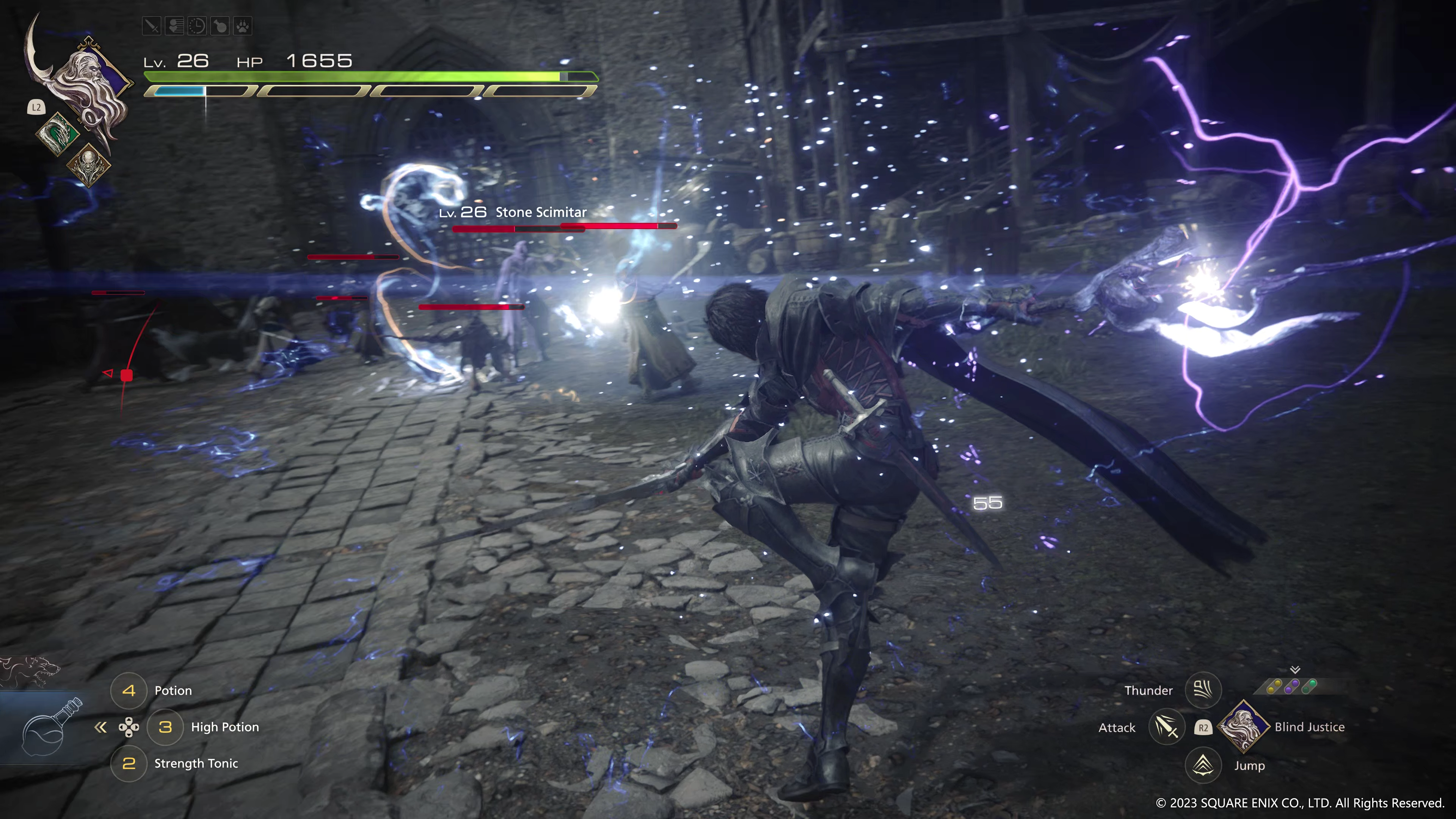
XVI’s combat is as gripping as it is flashy.
On the merits of its mature story and characters alone, XVI is worth playing, but the game has much more to it even if none of that appeals to you. As previously mentioned, this is inherently an action game — so much so, in fact, that CBU III tapped Devil May Cry 5 and Dragon’s Dogma alum Ryota Suzuki to serve as lead combat designer. And boy, do those influences show.
At face value, XVI certainly does look a lot like those action games. With sword in hand, Clive can hack, slash, twirl, and even jump cancel his way through battles with the level of ridiculous stylishness you’d expect from DMC‘s Dante. And sure enough, especially skilled players can definitely string together complex, lengthy combos to add layers to the flashiness.
But what’s most impressive about XVI‘s combat system is its versatility, both in terms of Clive’s arsenal and its player approachability as a whole. With respect to the latter, Square Enix has admirably added a ‘Story Focused’ mode and assistive accessories that simplify combat through automatic dodges, streamlined combos, and more. For people coming into XVI who aren’t used to the likes of DMC, these are excellent options to have, although they’re unfortunately not proper accessibility solutions for those with disabilities.
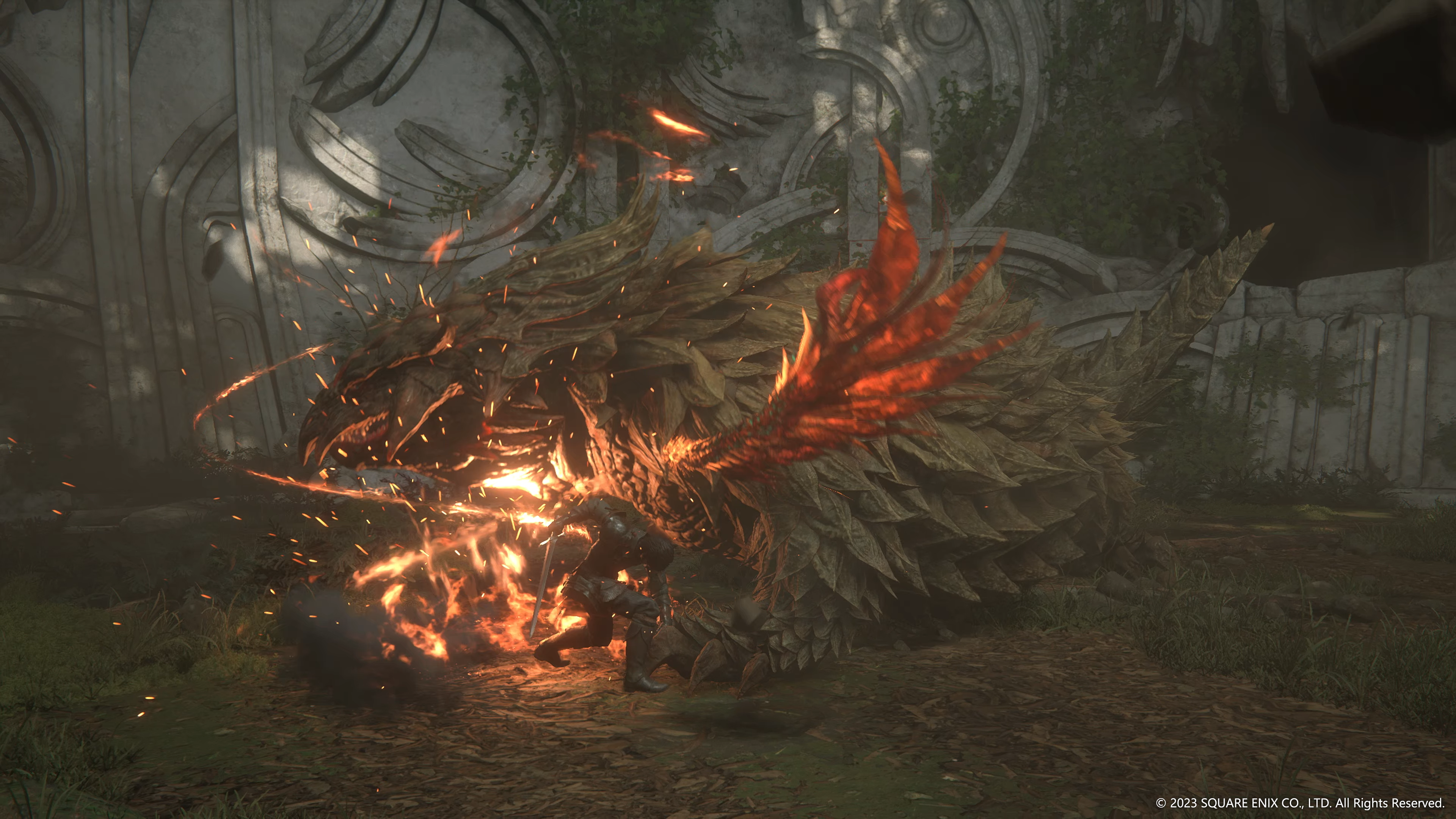
One-Winged Angel.
XVI has what’s easily one of my favourite combat systems to date. It’s robust enough to let you play it like a DMC if you so choose, but for the less technical players, like myself, it still has oodles of depth. That’s because XVI incorporates the series’ best use of summons (“Eikons”) to date. In place of lengthy summoning cutscenes à la classic FFs or even XV or temporary AI-controlled allies as in VII Remake, XVI‘s Eikons are all about their customization.
Thanks to Joshua’s blessing, Clive is able to wield some of the Phoenix’s powers, which give him special moves in the form of a few fiery wing-based dashes and strikes. Since these operate on a cooldown, your options are fairly limited at the start. But before long, you’ll gain new Eikonic abilities from other Dominants, such as Benedikta’s wind-based Garuda and the ruthless Hugo’s rock-centric Titan. Each Eikon has its own small skill tree through which you can use Ability Points accrued through levelling to acquire new abilities and master old ones.
As such, XVI has “loadouts” of sorts, incentivizing you to routinely experiment with Eikon configurations. Graciously, any mastered ability can be equipped to any Eikon set, so you can mix and match moves without being locked to any particular Eikon. At the same time, XVI only allows you to equip three sets at a time, so you have to be a bit more thoughtful in how you approach them. I’ll confess that this felt frustratingly limiting at first, but I soon appreciated that it added a level of strategy to combat and, through that, made me appreciate each Eikon’s unique strengths all the more. In fact, these customization options are where the game most feels like an RPG, as the actual progression systems — including a painfully linear gear upgrade system that is almost entirely unlocked alongside the story — leave much to be desired. While I wish you had more variety in the kinds of gear you can unlock, the combination of radically different Eikons and a suite of accessories to enhance each of their individual abilities at least felt quite rewarding.
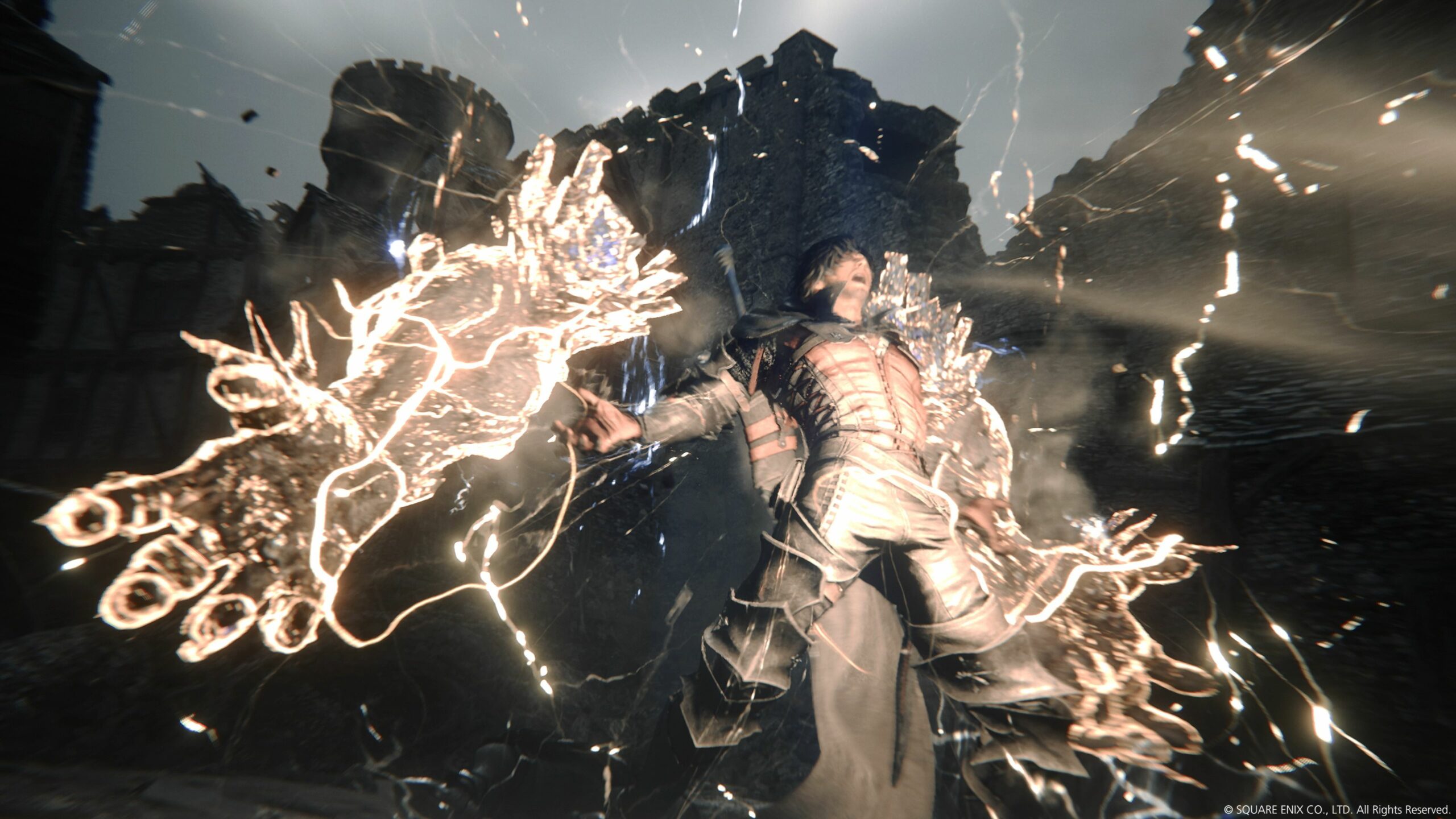
These fists were made for pummeling, and that’s just what they’ll do.
For instance, I adored how Titan’s Raging Fists attack pummels enemies with comically oversized rocky fists while also offering a parry functionality to increase its effectiveness. On the flip side, Odin’s Gungnir ability does far less damage but unleashes a balletic flurry of spear slices and strokes to fill a ‘Zantetsuken’ gauge for an all-powerful finishing move. Each move has its own cooldown, creating a euphoric sense of freedom as I seamlessly swapped between Eikon sets on the fly. A particular favourite was using Garuda’s Aerial Blast to conjure up a slow but deadly tornado to ensnare a group of enemies and then switch to Phoenix’s Flames of Rebirth to pummel them all at once with a pillar of flames. XVI is a pretty stunning game throughout, but it’s in these sorts of magical attacks — the smokey little embers encircling a plume of charcoal smoke — that the visuals become truly spellbinding. (It also has one of the most consistent 30fps modes I’ve ever seen with almost no dips at all, so I actually played on the 4K Resolution Mode to fully enjoy all of the splendor.)
If that weren’t enough, XVI has easily the series’ most sizeable enemy variety to date, offering clever reimaginings of classic FF creatures like the toxic and tentacled plant-like Malboros and snarling, fanged Behemoths while throwing in twists on traditional fantastic beasts like trolls and wolves. But it’s the boss fights that are, without a doubt, XVI‘s greatest achievement on the gameplay front. Traditional boss encounters against monsters or magical humans are all great in their own right, and that’s before we even get to the Godzilla-esque Eikon fights.
Yes, XVI lets Clive take on the form of the horned fire demon Ifrit to battle other massive Eikons, and this results in, bar none, some of the best boss fights I’ve ever seen in a game. The sense of awe in discovering the ever-escalating scope of these Kaiju-inspired clashes — taking us from the ground to the sky and even outer space and back with earth-shattering force — never ceases to amaze, and it makes the inevitable Dominant encounters feel all the more exciting. To say too much more about these would spoil the many jaw-dropping, cheer-worthy moments found throughout, but suffice it to say that each Eikon skirmish is incredibly memorable and thrilling. The only issue is some of these rely on the occasional dated Quick-Time Event (QTE), but thankfully, the bulk of these Eikon battles are fully interactive. Complementing all of this is XIV composer Masayoshi Soken’s sublime score, which mixes grand operatic symphonies with badass guitar and vocal pieces to make each boss feel even more rousing. The way Soken wonderfully mixes majestic new pieces with beautiful homages to classic Nobuo Uematsu scores from the likes of original Final Fantasy to Final Fantasy VIII is nothing short of magical.
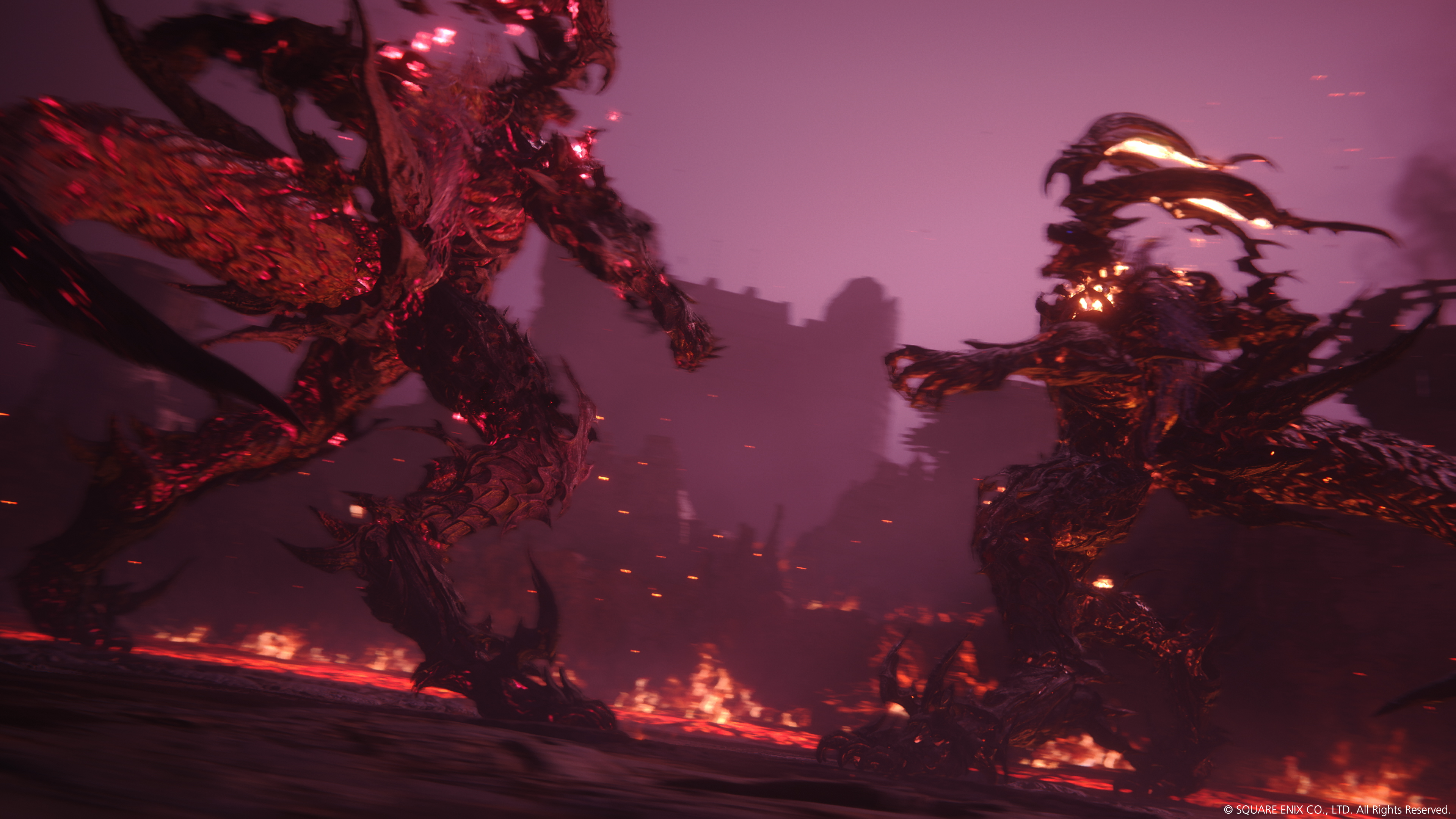
Somehow, Eikon battles get even bigger than this.
The only area in which combat truly falls short is through its “party system.” I use quotation marks because you have absolutely zero influence over the characters who are with you, particularly Torgal, Clive’s lovable wolf companion who accompanies him for the bulk of the game. Given the action focus, it’s not inherently a problem to only directly control Clive, but the inability to at least customize Torgal, Jill and other allies with whom you’ll spend many hours in battle feels maddeningly restrictive. Calling this a “party” without allowing for even the most basic of customization options feels like cheap lip service to an FF series staple. Even something like Square Enix’s Kingdom Hearts series allows you to gear up and tweak the AI behaviour of your friends, and XVI would have benefited from offering something similar.
A small but compelling world
During the press tour for XVI, CBU III has been candid about how XVI is not an open-world game. For me, that isn’t actually a bad thing at all. Far too many modern games get sucked into that framework as if to check off a list, suffering from bloat as a result. That said, this means you still have to do something purposeful with the smaller explorable areas you create, and therein lies XVI‘s greatest failing.
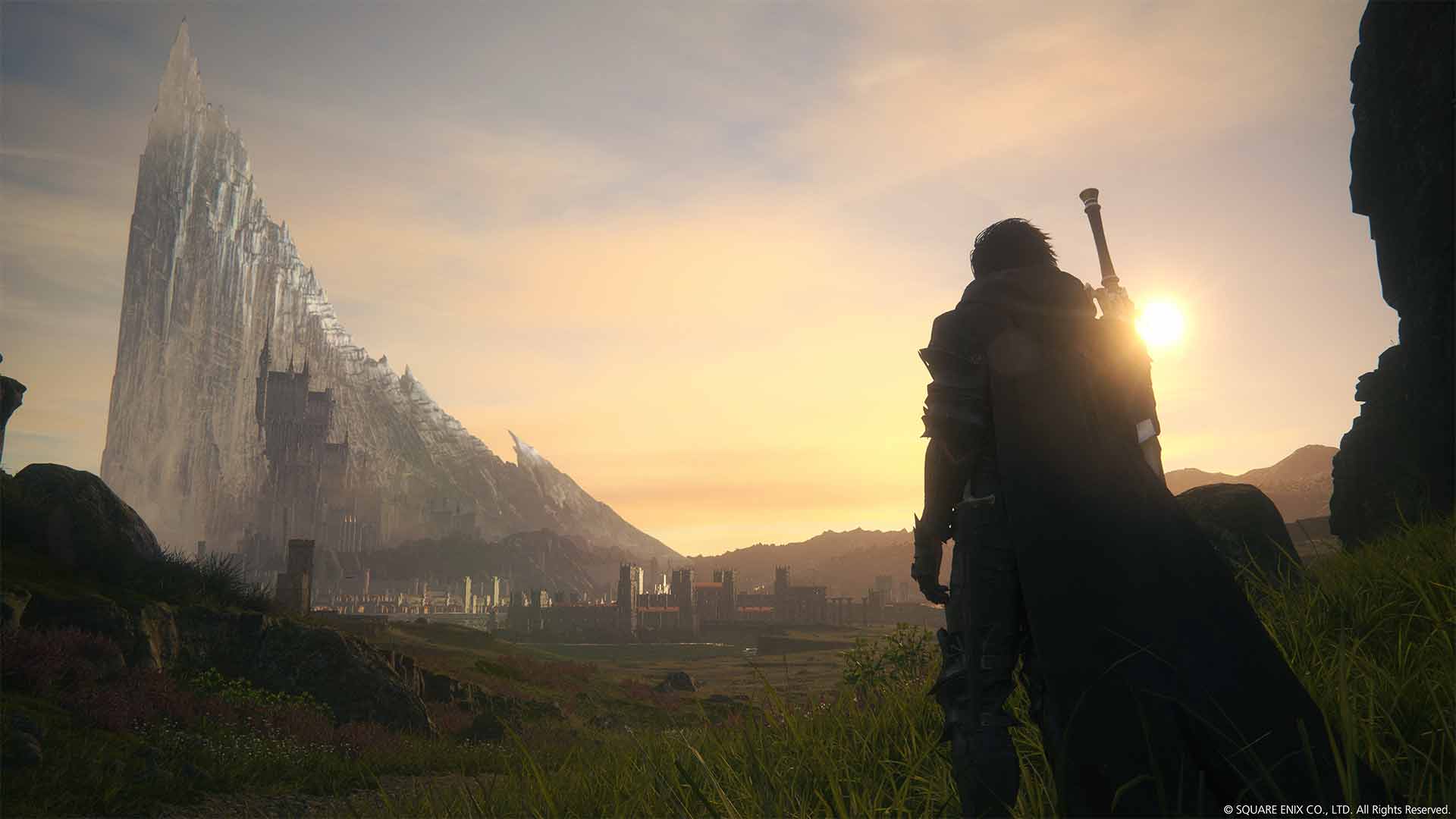
XVI is a gorgeous game.
Simply put, far too many areas in XVI feel expansive just for the sake of it, offering absolutely no real incentive to traverse through them beyond getting from Point A to B. The occasional chest or item will be placed throughout, but these are minor rewards that don’t meaningfully add depth to these barren environments. This is perhaps best exemplified in one late-game section; I came across a small village overrun by enemies, so naturally, I made a point of hunting down and felling each one. By the end of that, though, I found nothing except a couple of chests with some basic crafting ingredients for the game’s aforementioned rudimentary gear system. What could have been an opportunity to discover an unmarked sidequest, explorable houses or even optional dialogue was instead ostensibly just filler for the map, and that’s the sort of thing you see often in XVI‘s locales.
With such shallow level design, your only other reason for returning to areas and venturing out further is the game’s many sidequests. However, these, too, feel undercooked; I’d wager that the first few dozen of these are your standard, rote “go kill this enemy” or “fetch this item.” While generally well-written from a dialogue perspective, they’re otherwise woefully lacking any real meat. If nothing else, XVI cordially marks sidequests that unlock useful features like Chocobo riding and increased item potency with a plus sign, so you can focus your attention on those.
And to their credit, XVI‘s sidequests become much more interesting as you progress through the campaign. Eventually, you’ll discover more emotionally-charged and character-driven pieces, like finding out about Cid’s uncouth merchant Charon’s checkered past or helping beleaguered townspeople rebuild their home. One particularly wholesome sidequest involved Clive and Torgal revisiting their past, and it had me in tears as someone who recently lost his dog.
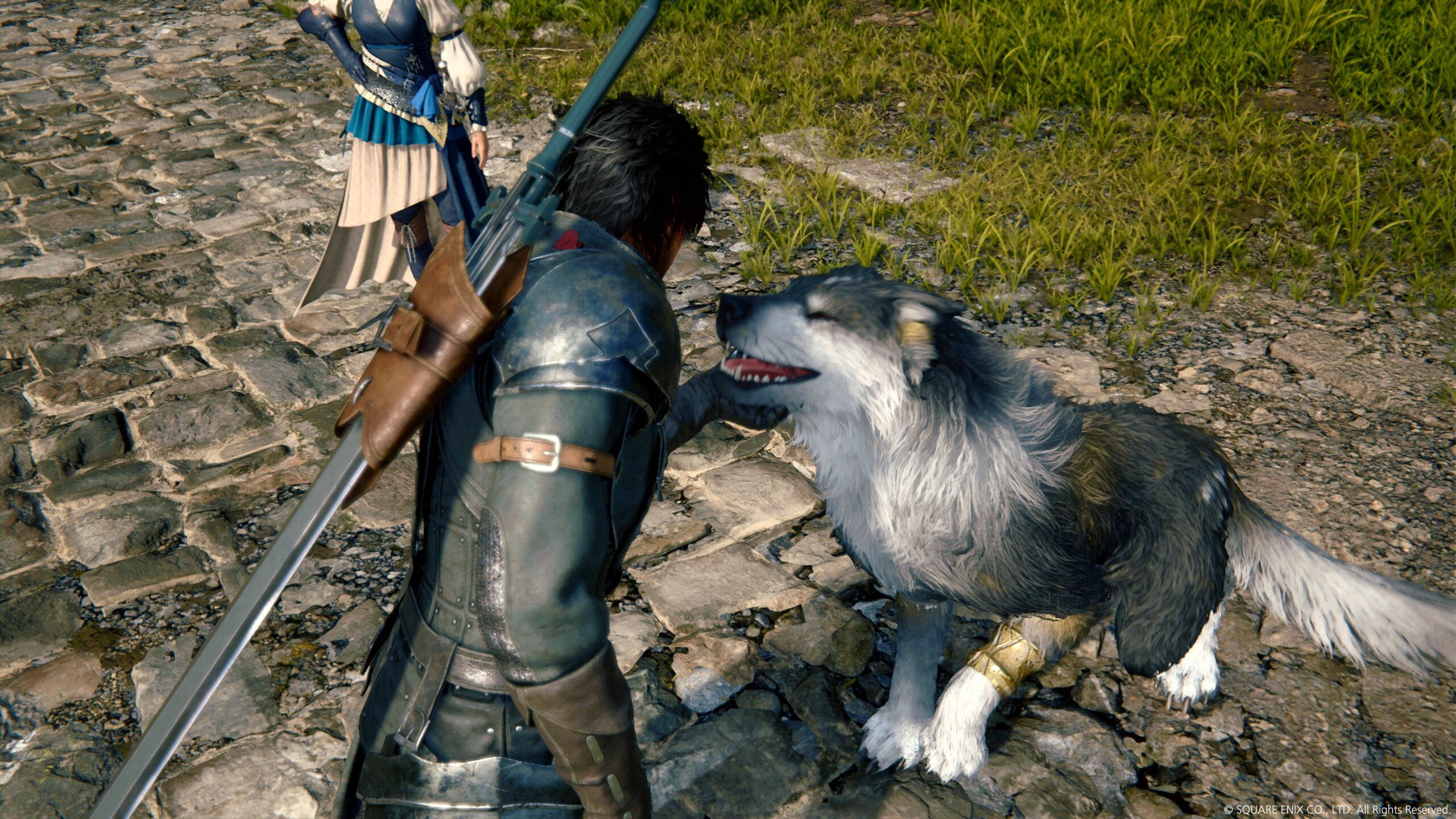
Torgal is a good boy.
It’s through these late-game sidequests that XVI‘s optional content ultimately proves worthwhile. In between missions, you return to Cid’s hideaway, a bustling hub that houses his allies and other downtrodden folks. Many of the sidequests relate to these characters, deepening your bond with them accordingly. It puts a human face to XVI‘s broader conflict, reminding you of what Clive is fighting for in the process. Not since the Mass Effect series have I felt so eager to return to a hub area to check in with all of the NPCs, so fleshed out and likable as they all are. This sense of community that Clive fosters is, in many ways, the beating heart of XVI, and I felt a deeper emotional attachment to the whole gang as a result.
A new kind of fantasy
Amid all of the discourse surrounding this game and the meaning of Final Fantasy as a whole, I’m reminded of why I love this series in the first place. While people feel an FF game should only be this or that, I mostly just appreciate the anthological nature of it all. For more than 35 years, Final Fantasy has endured because of its ability to redefine itself with each entry, taking big risks and bold swings where many franchises would not.
With Final Fantasy XVI, Creative Business Unit III has gone for an experience that’s both grittier in tone and narrative and more over-the-top and snazzy in gameplay. That approach certainly doesn’t appeal to everyone, but it’s one that absolutely works for me. True, XVI doesn’t always reach its lofty ambitions, but at its core lies a thoroughly heartfelt story filled with outstanding characters and a masterful combat system that is thoroughly engaging and enrapturing. It’s simultaneously beautifully faithful to the spirit of Final Fantasy and something refreshingly distinct, and I wouldn’t have it any other way.
Final Fantasy XVI is now available on PlayStation 5. A free demo is available on the PlayStation Store, and progress can be carried over to the final product.
Image credit: Square Enix
